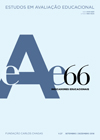Assessment of learning inequalities among elementary school students
DOI:
https://doi.org/10.18222/eae.v27i66.4101Keywords:
Educational Indicators, Educational Inequalities, Prova Brasil, Basic Education.Abstract
Educational equality, as defined in this article, is a condition in which any group of students presents the same performance distribution whose values match the learning experiences that enable them to have a productive and personally satisfying insertion into society. The main objective of this article is to introduce an indicator of educational inequality defined as the gap between the ideal performance distribution and that observed in a given group of students. The analyses presented here show that inequality in Brazilian elementary schools is very large and will never disappear if the improvements continue at the current pace.
Downloads
References
ALVES, Maria Teresa Gonzaga; SOARES, José Francisco; XAVIER, Flavia Pereira. Índice socioeconômico das escolas de educação básica brasileiras. Ensaio: Avaliação e Políticas Públicas em Educação, Rio de Janeiro, v. 22, n. 84, p. 671-703, set. 2014.
ALVES, Maria Teresa Gonzaga; SOARES, José Francisco; XAVIER, Flavia Pereira. Desigualdades educacionais no ensino fundamental de 2005 a 2013: hiato entre grupos sociais. Belo Horizonte. 2016.
ANGUS, John E. The probability integral transform and related results. Siam Review, v. 36, n. 4, p. 652-654, 1994.
BRASIL. Constituição (1988). Constituição da República Federativa do Brasil: Texto Constitucional promulgado em 5 de outubro de 1988, com as alterações anotadas pelas Emendas Constitucionais nos 1/92 a 44/2004 e pelas Emendas Constitucionais de Revisão nos 1 a 6/94. Brasília, DF: Senado Federal, Subsecretaria de Edições Técnicas, 2004. 438 p.
BRASIL. Instituto Nacional de Estudos e Pesquisas Educacionais Anísio Teixeira. Nota técnica: Índice de Desenvolvimento da Educação Básica – Ideb. Metodologia da concepção do IDEB. Brasília, DF: Inep, 2007.
CIZEK, Gregory J.; BUNCH, Michael B. Standard setting: a guide to establishing and evaluating performance standards on tests. Thousand Oaks, CA: Sage, 2007.
HANDCOCK, Mark S.; MORRIS, Martina. Relative distribution methods. Sociological Methodology, v. 28, n. 1, p. 53-97, 1998.
HANDCOCK, Mark S.; MORRIS, Martina. Relative distribution methods in the social sciences. New York: Springer Science & Business Media, 2006.
KLEIN, R.; FONTANIVE, N. S.; MOURA, F. Utilização da teoria de resposta ao item no Sistema Nacional de Avaliação da Educação Básica. Ensaio: Avaliação e Políticas Públicas em Educação, Rio de Janeiro, v. 11, n. 40, p. 283-296, jul./set. 2003.
KULLBACK, Solomon; LEIBLER, Richard A. On information and sufficiency. The Annals of Mathematical Statistics, v. 22, n. 1, p. 79-86, 1951.
OLIVEIRA, Romualdo Portela et al. Análise das desigualdades intraescolares no Brasil. 2013: projeto de pesquisa. São Paulo: Universidade de São Paulo, 2013.
Disponível em: <http://www.fvc.org.br/estudos-e-pesquisas/2012/pdf/relatorio-final-analise-desigualdades-intraescolares-brasil.pdf>. Acesso em: 19 set. 2016.
QEdu. Use dados. Transforme a educação. 2011. Disponível em: <http://www.qedu.org.br/>. Acesso em: 3 jul. 2016.
R DEVELOPMENT CORE TEAM. R: a language and environment for statistical computing. Viena, Austria, 2013. Disponível em: . Acesso em: 6 dez. 2016.
RIBEIRO, Ana Elisa; COSCARELLI, Carla Viana. O que dizem as matrizes de habilidades sobre a leitura em ambientes digitais. Educação em Revista, Belo Horizonte, v. 26, n. 3, p. 317, 2010.
RODRIGUES, Clarissa Guimarães; RIOS-NETO, Eduardo Luiz Gonçalves; PINTO, Cristine Campos de Xavier. Diferenças intertemporais na média e distribuição do desempenho escolar no Brasil: o papel do nível socioeconômico, 1997 a 2005. Revista Brasileira de Estudos Populares, Rio de Janeiro, v. 28, n. 1, p. 5-36, 2011.
SEN, Amartya. Equality of what? Tanner lecture on human values. Tanner Lectures. Salt Lake City, UT: Stanford Universty, 1979.
SHLENS, Jonathon. Notes on Kullback-Leibler divergence and likelihood. arXivpreprint arXiv:1404, 2000, 2014.
SILVERMAN, Bernard W. Density estimation for statistic and data analysis. Londres: CRC Press, 1986.
SOARES, José Francisco. Measuring cognitive achievement gaps and inequalities: the case of Brazil. International Journal of Educational Research, v. 45, n. 3, p. 176-187, 2006.
SOARES, José Francisco. Índice de Desenvolvimento da Educação de São Paulo – IDESP. São Paulo Perspectiva, São Paulo, v. 23, n. 1, p. 29-41, 2009.
SOARES, José Francisco; ALVES, Maria Teresa Gonzaga; XAVIER, Flávia Pereira. Effects of Brazilian schools on student learning. Assessment in Education. Principles, Policy & Practice, v. 23, n. 1, p. 75-97, 2016.
SOARES, José Francisco; MAROTTA, Luana Castro de Souza; DELGADO, Victor Maia Senna. Measuring the quality and equity of basic education systems. In: ISA WORLD CONGRESS OF SOCIOLOGY, 17, 2010, Sweden. Proceedings… Sweden, 2010.
THOMAS, Vinod; WANG, Yan; FAN, Xibo. Measuring education in equality: Gini coefficient of education. Washington, DC: World Bank, 2001.
TODOS PELA EDUCAÇÃO. De olho nas metas: primeiro relatório de acompanhamento das 5 metas do movimento todos pela educação. Comissão técnica do compromisso Todos pela Educação. São Paulo, 2008. Disponível em: <http://www.todospelaeducacao.org.br//arquivos/biblioteca/1a60588b-054d-4422-9a4f-0f009d7b2039.pdf>. Acesso em: 19 set. 2016.
Downloads
Published
How to Cite
Issue
Section
License
Copyright (c) 2016 Estudos em Avaliação Educacional

This work is licensed under a Creative Commons Attribution-NonCommercial 4.0 International License.
Authors who publish in this journal agree to the following terms:
a. Authors retain the copyright and grant the journal the right to first publication, with the paper simultaneously licensed under the Creative Commons Attribution License (CC BY 4.0) license that allows the sharing of the paper with acknowledgment of authorship and initial publication in this journal.
b. Authors are authorized to assume additional contracts separately, for non-exclusive distribution of the version of the paper published in this journal (for example publishing in institutional repository or as a book chapter), with acknowledgment of authorship and initial publication in this journal.
c. Authors are allowed and encouraged to publish and distribute their paper on-line (for example in institutional repositories or on their personal page) at any moment before or during the editorial process, as this can generate productive changes, as well as increase the impact and citation of the published paper (See The Effect of Open Access).







